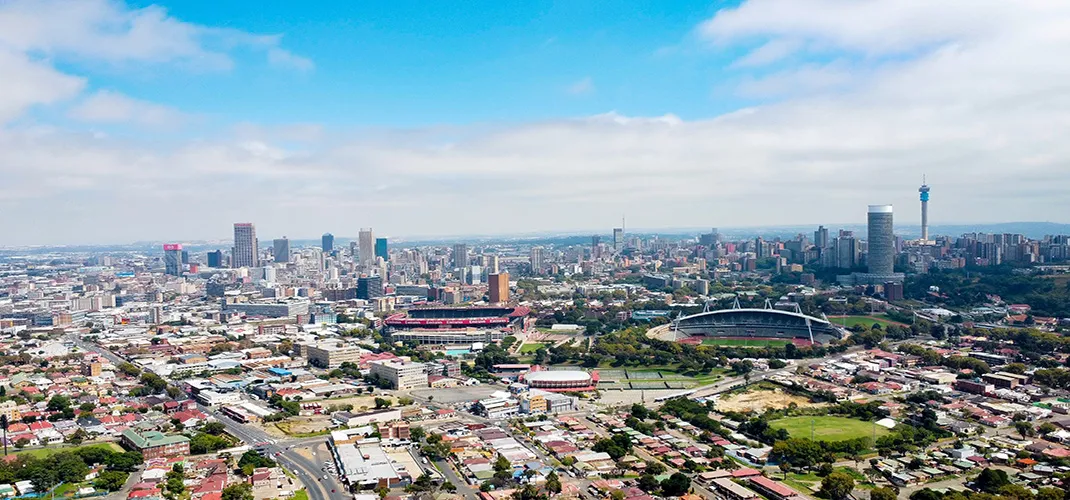Johannesburg

Johannesburg or Jo’burg is South Africa’s biggest city. Born out of the discovery of Gold in 1896, Johannesburg fell into decline with the ‘white flight’ of the transition between apartheid and multi-party democracy. However, now, local communities are taking back the streets as proven by the redevelopment of Maboneng and Newtown.
The seat of the Constitutional Court of South Africa, Constitution Hill, dates back to the earliest days of Johannesburg. A Fort turned Prison turned Museum with its walls having incarcerated names including Mahatma Gandhi and Nelson Mandela. There are three main buildings, the Old Fort, Women’s Jail and Number Four or Native Prison. The museum plays another important part in recording the devastating effects of apartheid. There’s a café filled with delicious treats, which sits alongside a perpetual Flame of Democracy lit by Nelson Mandela on the 15th Anniversary of South Africa’s new constitution in 2011.
The Apartheid Museum opened in late 2001 and is located midway between Johannesburg’s CBD and Soweto. Part of the Gold Reef City Amusement Park, its prison like structure houses the foremost review of the country’s former policies of racial segregation. Both hard hitting and touching, the realities of apartheid are brought to life through cleverly thought out curation. This includes having two entrances with visitors randomly split between them. The exhibits and displays don’t shy away from 40 years of events, including the Sharpeville Massacre and Soweto Uprising, days that led to the deaths of hundreds of innocent civilians.
Gandhi Square is located in Marshalltown, an area of office blocks belonging to the big banks. This large plaza is named after the Indian activist, a lawyer in Johannesburg in his early life. It was here, when known as Government Square, that Afrikaner Boer forces surrendered to the British Military to end the siege of the city in 1900. On the boundary area of the square a number of beautifully designed heritage buildings have avoided the onslaught of the modern tower blocks.
Right at the centre of Johannesburg in Joubert Park and the Johannesburg Art Gallery, which houses a collection larger than any other similar museum in Africa. Containing fifteen connected gallery spaces and a small sculpture garden, its exhibits range from 17th Century Dutch works to modern homegrown art. Some of the famous names include Picasso, Rodin and Moore however, the main reason to visit is to see and learn more about South African Art.
Soweto, once short for the South West Townships, was created to house non-white Johannesburg residents outside of the city centre. The scene of various anti-apartheid actions including the 1976 Soweto Uprising. Today, it holds several important landmarks, which would best be explored as part of an organised tour, Soweto’s landmarks include the Walter Sisulu Square, the Mandela House Museum and the 33 story high Orlando Towers, which are covered in bright murals. Once a former power station cooling towers they are now one of the most exciting bungee jumping spots.
The Maboneng Precinct is awash with fresh things to see, do and taste. A destination par excellence for lovers of all things artistic and street art. At the heart of the neighbourhood, you find no shortage of trendy shops and cafés. In the evening the nightclubs come alive especially on a Saturday night, when Maboneng is undoubtedly the place to head for a good time. If you stay awake long enough you can even turn your attention to Sunday Market on Main, at Art on Main.
Newtown formally known as Brickfields, isn’t all that new dating back to the late 1800’s. It has several historically important buildings, including Turbine Hall. The quiet streets of Newtown are known for their performance spaces, which range from The Market Theatre to the Carfax live music venue. It is also the location of the Sci-Bono Discovery Centre Science Museum and The Workers’ Museum.
Johannesburg Botanical Gardens covers an area of 81 hectares. Divided into a number of small gardens, visitors will find an arboretum of trees from around the world, a succulent garden of 85 species and Shakespeare garden with herbs mentioned in the bards plays. That’s in addition to a rose garden and reservoir created by the Emmarentia Dam.
Other places to include on your next visit to Jo’burg include the Museum Africa, which occupies a fruit and vegetable market building constructed in 1913. Its responsibility is to cover the cultures of the entire continent with exhibits of musical instruments, masks and traditional clothing amongst other items.
The Wits Art Museum is one of Johannesburg’s newest attractions. It houses around 10,000 individual works of art in the gallery’s 5,000 square metres of exhibition space. The museum houses a tightly curated selection of both traditional artworks such as carvings and contemporary creations.
At the Origins Centre, you can step back more than two million years. Dedicated to the journey of human evolution, this museum helps to unravel not only our biological evolution but also our development of art and culture. Focusing on humans from Southern Africa, the Origins Centre protects an impressive array of rock art for future generations.
Braamfontein is a fashion and music hub and the weekend is usually the best time to visit this part of Johannesburg, since students are free of their lectures. Things to do include the Neighbourhoods Market where you can check-out two floors of clothing, food and drink with the rooftop bar making the best location. Not far away there are more traditional stores as well as a rooftop farm.
